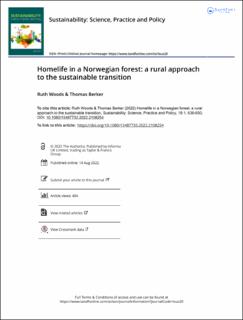| dc.contributor.author | Woods, Ruth | |
| dc.contributor.author | Berker, Thomas | |
| dc.date.accessioned | 2023-02-28T08:14:42Z | |
| dc.date.available | 2023-02-28T08:14:42Z | |
| dc.date.created | 2022-09-03T13:28:50Z | |
| dc.date.issued | 2022 | |
| dc.identifier.citation | Sustainability: Science, Practice, & Policy. 2022, 18 (1), 636-650. | en_US |
| dc.identifier.issn | 1548-7733 | |
| dc.identifier.uri | https://hdl.handle.net/11250/3054482 | |
| dc.description.abstract | The introduction of technical solutions and the phasing out of unsustainable technologies in Elverum, a small town in the middle of the Norwegian forest, is the starting point for this discussion about homelife and why it can be resistant to change. Sustainable ambitions, goals, and solutions are inspired by the challenges faced by urban neighborhoods, but rural communities are also dealing with the sustainable transition and require opportunities for change that are relevant within their particular context. This article takes an emic insider view of how innovative, and potentially more sustainable technology, affects homelife by considering four main themes: choosing where to live; relationships with cars; leisure activities; and how Ydalir—a zero-emission neighborhood being planned in Elverum—is understood within this context. Rather than smoothing over variations in needs and preferences inside and outside urban and rural contexts, engaging with differences helps to avoid misunderstandings and disappointments. The goal is to encourage a co-production of meaning when approaching the challenge of achieving goals for sustainable futures. Furthermore, associations between homelife and social sustainability offer a site where the sustainable practice is strong. Many rural communities already possess qualities, such as equity, social engagement, inclusion, social interaction, safety, and security. We propose that starting with social sustainability, rather than technical innovation, has the potential to encourage sustainable practices in rural communities, thereby increasing the appropriation and domestication of sustainable ambitions outside of urban contexts. | en_US |
| dc.language.iso | eng | en_US |
| dc.publisher | Taylor & Francis | en_US |
| dc.rights | Navngivelse 4.0 Internasjonal | * |
| dc.rights.uri | http://creativecommons.org/licenses/by/4.0/deed.no | * |
| dc.title | Homelife in a Norwegian forest: a rural approach to the sustainable transition | en_US |
| dc.title.alternative | Homelife in a Norwegian forest: a rural approach to the sustainable transition | en_US |
| dc.type | Peer reviewed | en_US |
| dc.type | Journal article | en_US |
| dc.description.version | publishedVersion | en_US |
| dc.source.pagenumber | 636-650 | en_US |
| dc.source.volume | 18 | en_US |
| dc.source.journal | Sustainability: Science, Practice, & Policy | en_US |
| dc.source.issue | 1 | en_US |
| dc.identifier.doi | 10.1080/15487733.2022.2108254 | |
| dc.identifier.cristin | 2048567 | |
| cristin.ispublished | true | |
| cristin.fulltext | original | |
| cristin.qualitycode | 1 | |

